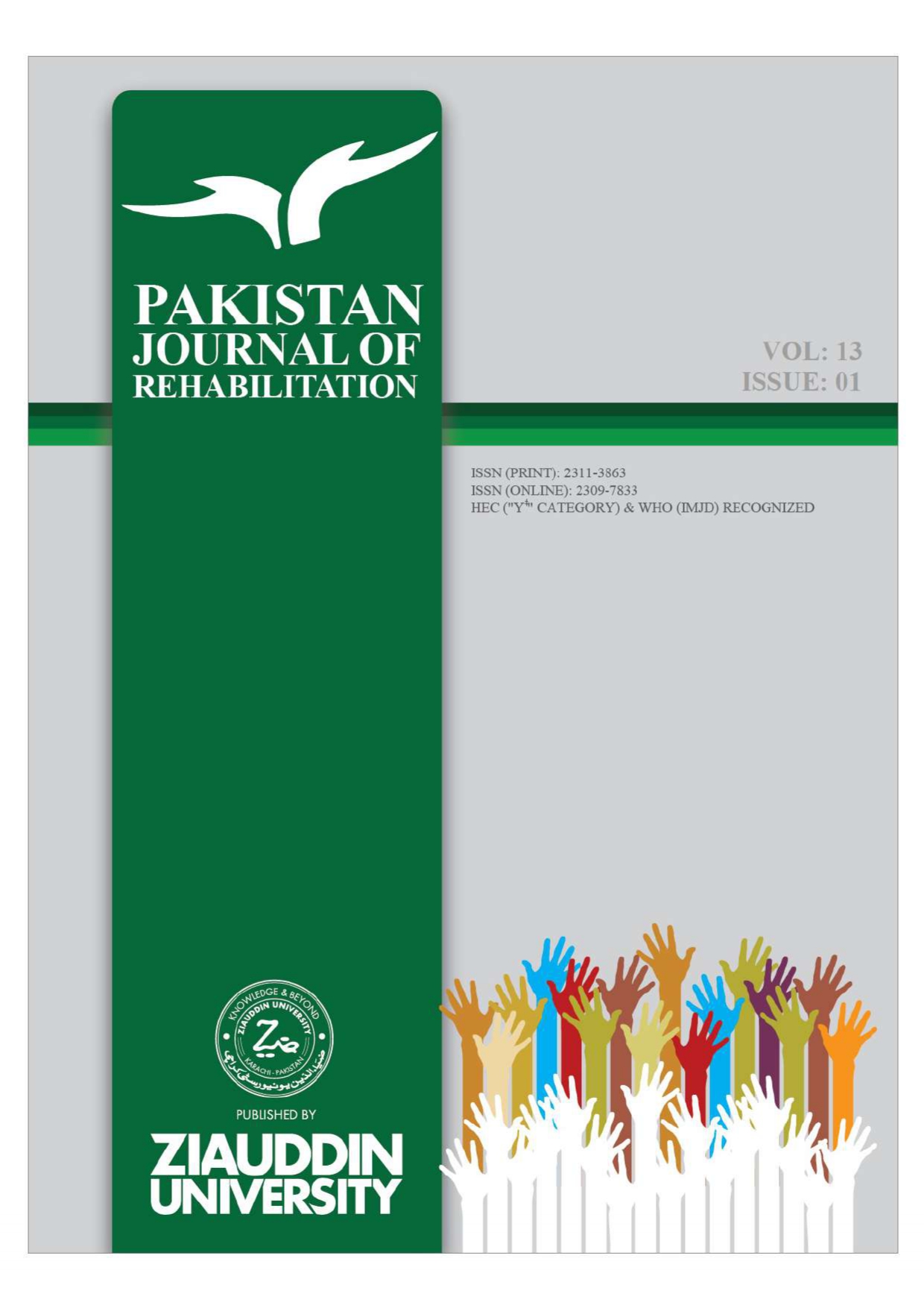MEASURE THE LEVEL OF SENSORY PROCESSING PROBLEM IN CHILDREN WITH AND WITH OUT AUTISM IN CLASSROOM ENVIRONMENT
Keywords:
Perception, SPM, sensory responses, sensory threshold, autism, autistic disorderAbstract
Background of the Study: Sensory processing is the process in which all sensory stimuli integrate and enable person to respond according to the situation. There are number of sensory issues that either parents or teacher do not identify on early stages and various times it also cause behavioral issues or academic issues with in typical children too. The study aims to assess the sensory vulnerability of children with and without autism in the school environment and to identify the sensory issues.
Methodology: This was a cross-sectional study conducted in Karachi, Pakistan. Total 86 children recruited and divided into two groups included typical and atypical children. Using a standardized questionnaire-SPM (sensory processing measure) distributed in schools and completed by teachers.
Result: Autism affects both mainstream children and children with autism, with sensory process subscales showing significant differences p value (< .005) for t- test. Autism children have higher sensory process vulnerability, particularly in social participation and praxis variables, compared to mainstream children’s.
Conclusion: The study reveals that school initiates sensory stimuli, affecting children's vulnerability, even in special schools, despite providing structured environments for atypical children.
References
Ayres, A. J. Sensory Integration and the Child. Los Angeles, CA: Western Psychological Services. Psychology. 2020;11(6)
Jawaria. S, Rizwana.W, Imran.A, Nighat.T. Comparing Sensory Processing Abilities of age- Matched Atypical and Typical School Going Children in Pakistan. International Journal of Research and Innovation in Social Science (IJRISS). 2019;3(11).
Fernández MIA, Cerverza PS. Comparative study of sensory modulation vulnerabilities in children with and without ASD in family and school contexts. Journal of Occupational Therapy Schools & Early Intervention. 2018:318-28.
Critz C, Blake K, Nogueira E. Sensory Processing Challenges in Children. The Journal for Nurse Practitioners – JNP. 2015;11(7): 710-6.
Amireh, M. M. H,Omer FEZAM. Caregivers’ Perspective about the Levels of Sensory Processing Problems in Children with Autism. Journal of Client-Centered Nursing Care. 2018
Parham et al., 2007, Sensory Processing Measure –SPM.
Jasmin, E. Sensori-motor and daily living skills of preschool children with autism spectrum disorders. Journal of Autism and Developmental Disorders. 2009;39(2): 231-41.
Nieto, C, Lopez B, Gandia H. Relationships between atypical sensory processing patterns, maladaptive behaviour and maternal stress in Spanish children with autism spectrum disorder. Journal of Intellectual Disability Research. 2017;61(12): 1140-50
Kausar T, Fazil H. Perceptions of Teachers on Prevalence of Sensory Problems among Children with Autism Spectrum Disorder. Pakistan Social Sciences Review. 2020;4(3):749-65.
Chien CW, Rodger S, Copley J, Branjerdporn G, Taggart C. Sensory processing and its relationship with children’s daily life participation. Physical and Occupational Therapy in Pediatrics, 2016;36: 73–87.
Costa R, Lampreia C. Findings on sensory deficits in autism: Implications for understanding the disorder. Psychology & Neuroscience. 2012;5:231–7.
Jewel E C, Salzinger E, Lin MH, Gavin WJ, Davies PL. Sensory Processing and Attention Profiles among Children with Sensory Processing Disorders and Autism Spectrum Disorders: Frontiers in Integrative Neuroscience. 2020:1-10
Pfeiffer B, Coster W, Snethen G, Derstine M, Piller A, Tucker C. Caregivers' Perspectives on the Sensory Environment and Participation in Daily Activities of Children With Autism Spectrum Disorder. Am J Occup Ther. 2017;71(4):1
Gabriels RL, Agnew JA, Miller LJ, Gralla J, Pan Z, Goldson E et al. Is there a relationship between restricted, repetitive, stereotyped behaviors and interests and abnormal sensory response in children with autism spectrum disorders?. Research in autism spectrum disorders. 2008;2(4):660-70..
Miller LJ, Nielsen DM, Schoen SA, Brett-Green BA. Perspectives on sensory processing disorder: a call for translational research. Frontiers in Integrative Neuroscience. 2009;3:597.
Tripathi HJ, Varma TV, Prabhakar KB. A Comparative Study using the Short Sensory Profile by the Caregivers on the Performance of Children With and Without Autism Spectrum Disorders.
Kuhaneck HM, Henry D, Glennon TJ. Sensory Processing Measure: SPM. Western Psychological Services (WPS); 2007.
Kilroy E, Aziz-Zadeh L, Cermak S. Ayres theories of autism and sensory integration revisited: What contemporary neuroscience has to say. Brain sciences. 2019;9(3):68.
Tomchek SD, Dunn W. Sensory processing in children with and without autism: a comparative study using the short sensory profile. The American journal of occupational therapy. 2007;61(2):190-200.
Sleeman HR, Brown T. An exploratory study of the relationship between typically-developing school-age children’s sensory processing and their activity participation. British Journal of Occupational Therapy. 2022;85(4):251-61.
Thye MD, Bednarz HM, Herringshaw AJ, Sartin EB, Kana RK. The impact of atypical sensory processing on social impairments in autism spectrum disorder. Developmental cognitive neuroscience. 2018;29:151-67.
Russell S, McCloskey CR. Parent perceptions of care received by children with an autism spectrum disorder. Journal of Pediatric Nursing. 2016;31(1):21-31.
Makin C, Hill V, Pellicano E. The primary-to-secondary school transition for children on the autism spectrum: A multi-informant mixed-methods study. Autism & Developmental Language Impairments. 2017; 2:2396941516684834.
Ayres AJ. Sensory integration and learning disorders. (No Title). 1972.
Ayres, A. J. Sensory integration and the child. Los Angeles, CA: Western Psychological Services. 1979
Brown NB, Dunn W. Relationship between context and sensory processing in children with autism. The American Journal of Occupational Therapy. 2010;64(3):474-83.
Rayan A, Ahmad M. Psychological distress in Jordanian parents of children with autism spectrum disorder: The role of positive reappraisal coping. Archives of Psychiatric Nursing. 2017;31(1):38-42.
Feroz R. Perspectives of Facilitators and Parents about the Development of ASD Children.

Additional Files
Published
How to Cite
Issue
Section
License
Copyright (c) 2024 Pakistan Journal of Rehabilitation

This work is licensed under a Creative Commons Attribution 4.0 International License.



